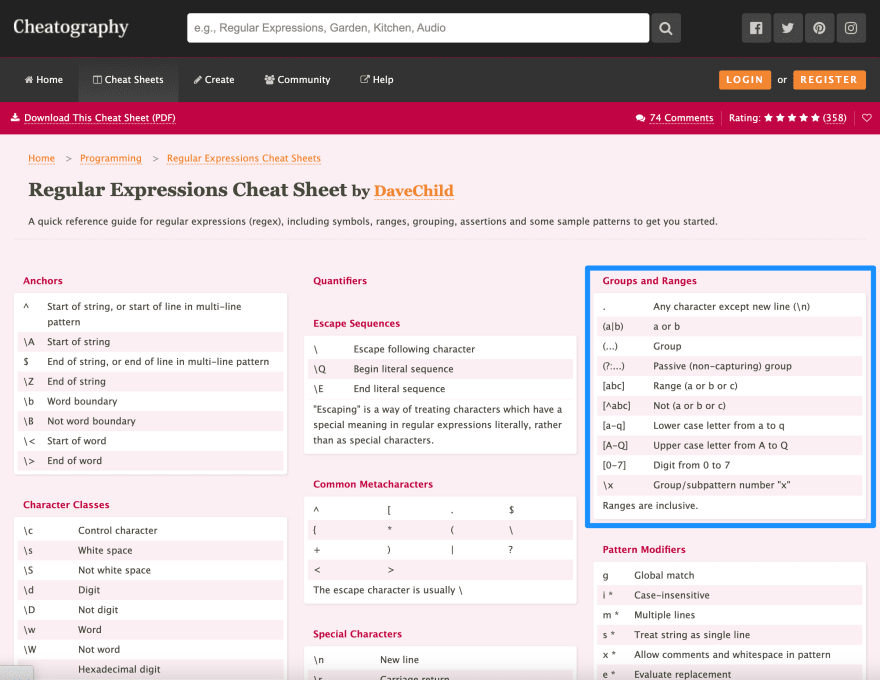An Interest In:
Web News this Week
- April 1, 2024
- March 31, 2024
- March 30, 2024
- March 29, 2024
- March 28, 2024
- March 27, 2024
- March 26, 2024
Cheatsheet for the Regex Cheatsheet, Part VII: Groups & Ranges
Intro
I was recently doing a code challenge for a job interview that required me to strip out all nonalphabetic characters. "Ah! I should use Regular Expressions for this!" I thought in triumph, impressed that I even knew what regular expressions were. That fleeting moment of glory faded once I decided to brush up on regular expressions and landed on the encouragingly-named Regular Expressions Cheatsheet. I had no idea how to use it!
So, for people like me, here is a Cheatsheet for the Regular Expressions Cheatsheet, Part VII: Groups & Ranges
What's are Groups & Ranges?
It does exactly what it says on the tin, as they say. Groups of characters and ranges of characters.
Anatomy of a regular expression
- Forward slashes go on either end like so:
/something/ - Add
gfor "global" at the end to find every instance, like so:/something/g - Add
mto "multi line" to the beginning/end of each line, not just the beginning/end of each string, like/something/gor/something/gm
Groups & Ranges
. Any character except new line (
)
.is used in/./gto find the following:The lion roared
Again- Example on regex101.com
- Example in Javascript:
let sentence = "The lion roared";let regex = /./g;let found = sentence.match(regex);console.log(found); // [ 'T', 'h', 'e', ' ', 'l', 'i', 'o', 'n', ' ', 'r', 'o', 'a', 'r', 'e', 'd', ' ', ' ', 'A', 'g', 'a', 'i', 'n'] (x|y) This character or that character (x or y)
(a|b)is used in/(a|b)/to find the following:The lion roared- Example on regex101.com
- Example in Javascript:
let sentence = "The lion roared";let regex = /(a|b)/;let found = sentence.match(regex);console.log(found); // [ 'a' ] [xyz] Range of characters (x or y or z)
[aeiou]is used in/[aeiou]/gto find the following:The lion roared- Example on regex101.com
- Example in Javascript:
let sentence = "The lion roared";let regex = /[aeiou]/g;let found = sentence.match(regex);console.log(found); // [ 'e', 'i', 'o', 'o', 'a', 'e' ] [^xyz] Not a range of characters (x or y or z)
[^aeiou]is used in/[^aeiou]/gto find the following:The lion roared- Example on regex101.com
- Example in Javascript:
let sentence = "The lion roared";let regex = /[^aeiou]/g;let found = sentence.match(regex);console.log(found); // [ 'T', 'h', ' ', 'l', 'n', ' ', 'r', 'r', 'd'] [x-z] Span from this character to that character (x through z)
[a-c]is used in/[a-c]/gto find the following:The lion roared a bunch of times- Example on regex101.com
- Example in Javascript:
let sentence = "The lion roared a bunch of times";let regex = /[a-c]/g;let found = sentence.match(regex);console.log(found); // [ 'a', 'a', 'b', 'c' ]Dunce Corner
\x Group/subpattern number "x"
I don't get this. MDN Web Docs says:
A back reference to the last substring matching the n parenthetical in the regular expression (counting left parentheses). For example, /apple(,)\sorange\1/ matches "apple, orange," in "apple, orange, cherry, peach".
I have read this about five times and I still don't know what they're talking about. But I also have low blood sugar at the moment, so...
Original Link: https://dev.to/mathlete/cheatsheet-for-the-regex-cheatsheet-part-vii-groups-ranges-32ne
Dev To
 An online community for sharing and discovering great ideas, having debates, and making friends
An online community for sharing and discovering great ideas, having debates, and making friendsMore About this Source Visit Dev To


